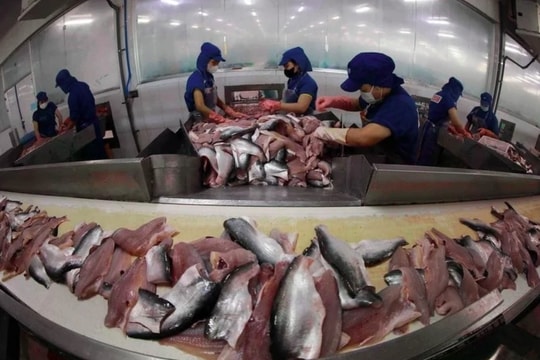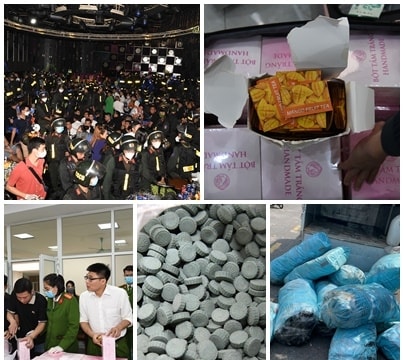 |
| Associate Professor Vũ Hải Quân, Director of Hồ Chí Minh City National University, speaks at the event. — Photo courtesy of the organiser |
HÀ NỘI — VinFuture Foundation organised the 'Science for Life' symposia on December 4, opening the VinFuture Sci-Tech Week and Award Ceremony series in Hà Nội which runs until December 7.
The symposia include four sessions on materials for a sustainable future, real-world deployment of AI, air pollution and the transport sector, along with the transformation in cardiovascular care and stroke treatment.
The event brought together world-leading scientists and experts in pivotal technological domains, including material sciences, AI and environmental studies.
The highlight of the Sci-Tech week will be the 2024 VinFuture Prize Award Ceremony on December 6, recognising scientists for their groundbreaking achievements that significantly impact the lives of billions worldwide.
Themed 'Resilient Rebound', this year's event signifies the transformative power of science and technology in enabling humanity to overcome adversity and build a prosperous future.
 |
| Panelists at the Materials for a Sustainable Future session on December 4 in Hà Nội. — Photo courtesy of the organiser |
At the discussion session on Materials for a Sustainable Future, experts and scientists said that one of the important factors in achieving clean energy goals is the development of new materials capable of increasing the performance of solar cells.
Speaking at the event, Associate Professor Vũ Hải Quân, Director of Hồ Chí Minh City National University, praised the outstanding contribution of the VinFuture Foundation in promoting the process of green transformation in Việt Nam.
Quân said that the symposia are not only a forum for academic exchange, but also a place to originate and form ideas and solutions with the potential to shape a better future for future generations.
“Renewable energy sources such as solar, wind and hydropower are increasingly becoming important pillars in solving the global energy crisis and reducing carbon emissions. In particular, materials for solar cells play a key role in increasing energy conversion efficiency and reducing production costs.
"These advances not only increase access to clean energy but also contribute to environmental protection and sustainable development. So, research and development of new materials for solar cells have become a core element in expanding renewable energy applications, thereby directly contributing to world sustainable development goals,” said Quân.
Professor Richard Henry Friend from Cambridge University emphasised the importance of renewable energy, especially solar cells, in reducing CO2 emissions and improving energy efficiency.
The academic said that energy is currently being consumed in an unsustainable way, causing serious problems, including excessive CO2 emissions, with the average person emitting tonnes of CO2 each year, efforts to mitigate climate change are more urgent than ever.
Professor Friend said: "We still have a viable option to solve this problem, which is to focus on solar energy."
 |
| Professor Martin Andrew Green, from New South Wales, in Australia speaks at the event. — Photo courtesy of the organiser |
Professor Martin Andrew Green, New South Wales, Australia, said that the third energy revolution could be a solar revolution, with new materials capable of converting solar energy into electricity with high efficiency and unprecedented low cost.
Green said that the price of solar cells has dropped from US$1/W in 2009 to about 10 cents/W today, while the efficiency of solar panels has increased from 16 per cent to 21.6 per cent. In addition, the size and shape of solar panels have also changed, providing greater efficiency in reducing installation and transportation costs.
Solar cell manufacturing technology has also made significant progress, from simple to advanced technologies, such as Topcon, heterojunction solar cells, IBC and PERC. These new technologies not only help increase the efficiency of solar cells but also reduce production costs, facilitating the use of solar energy to become more popular globally.
Discussing the role of Artificial Intelligence in developing new materials, Professor Nguyễn Thục Quyên, Chairwoman of the VinFuture Award Preliminary Council, said how it can, right from the design stage, help optimise solar materials.
“AI can help predict and analyse high-potential materials, reduce research time and improve production efficiency,” she added.
However, according to Professor Green, AI is not a 'magic pill' for all ills and needs to be used with caution. AI requires a rich and reliable database and must take into account factors such as energy efficiency, production costs and material recyclability.
“Although solar technology has made significant advances, to achieve the net zero goal by 2050, we still have many challenges to overcome.”
The professor's forecast is that by 2030, solar energy output needs to reach 3TB GW per year, but this requires drastic changes in technology and production scale.
Experts also said that it is necessary to combine new technologies, develop advanced materials and apply smart manufacturing methods to achieve sustainable energy goals.
In particular, the use of AI, the development of new materials such as perovskite and recycled polymers and the optimisation of manufacturing processes will be important factors that help people move closer to a clean and sustainable energy future. — VNS
























